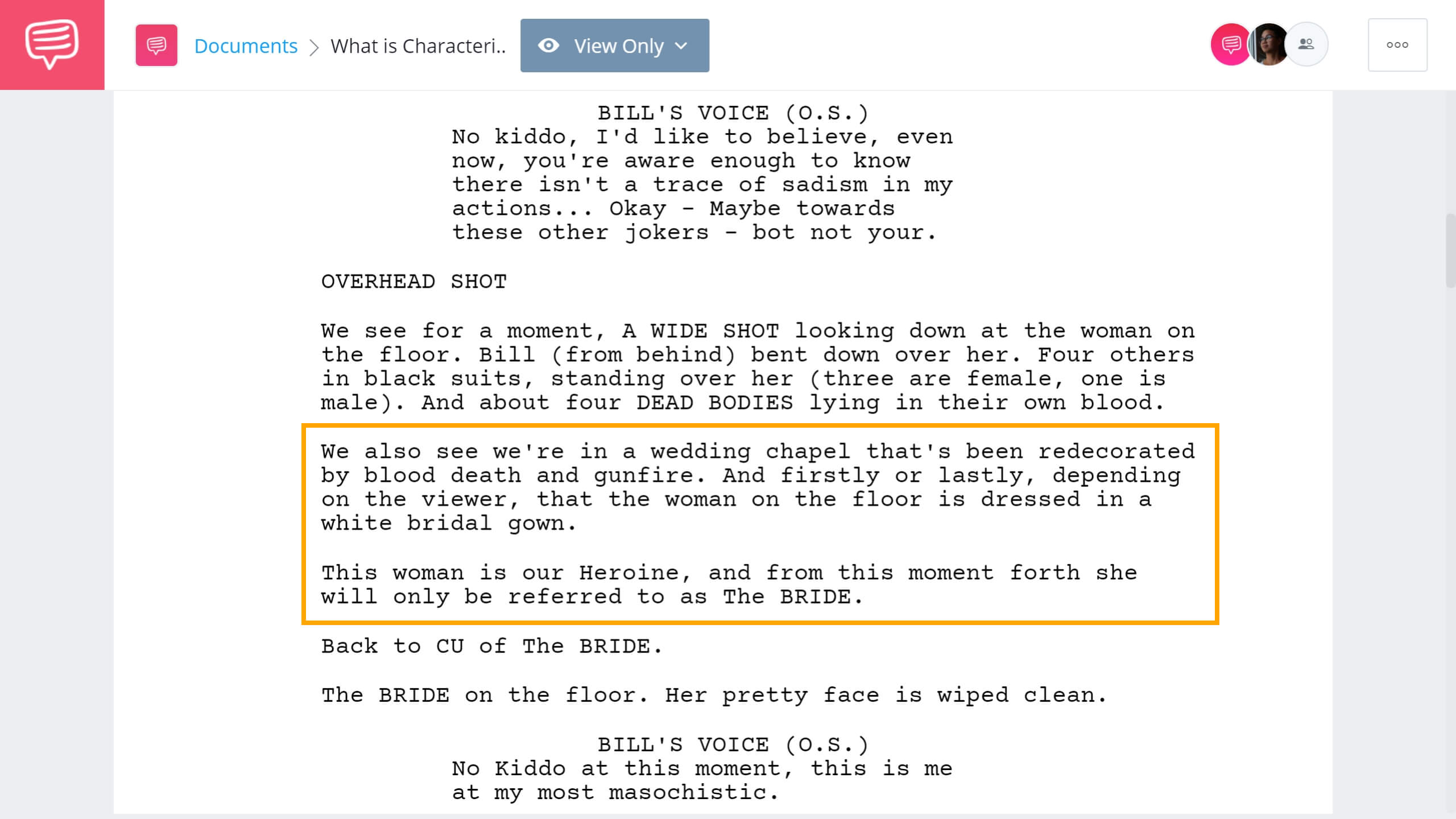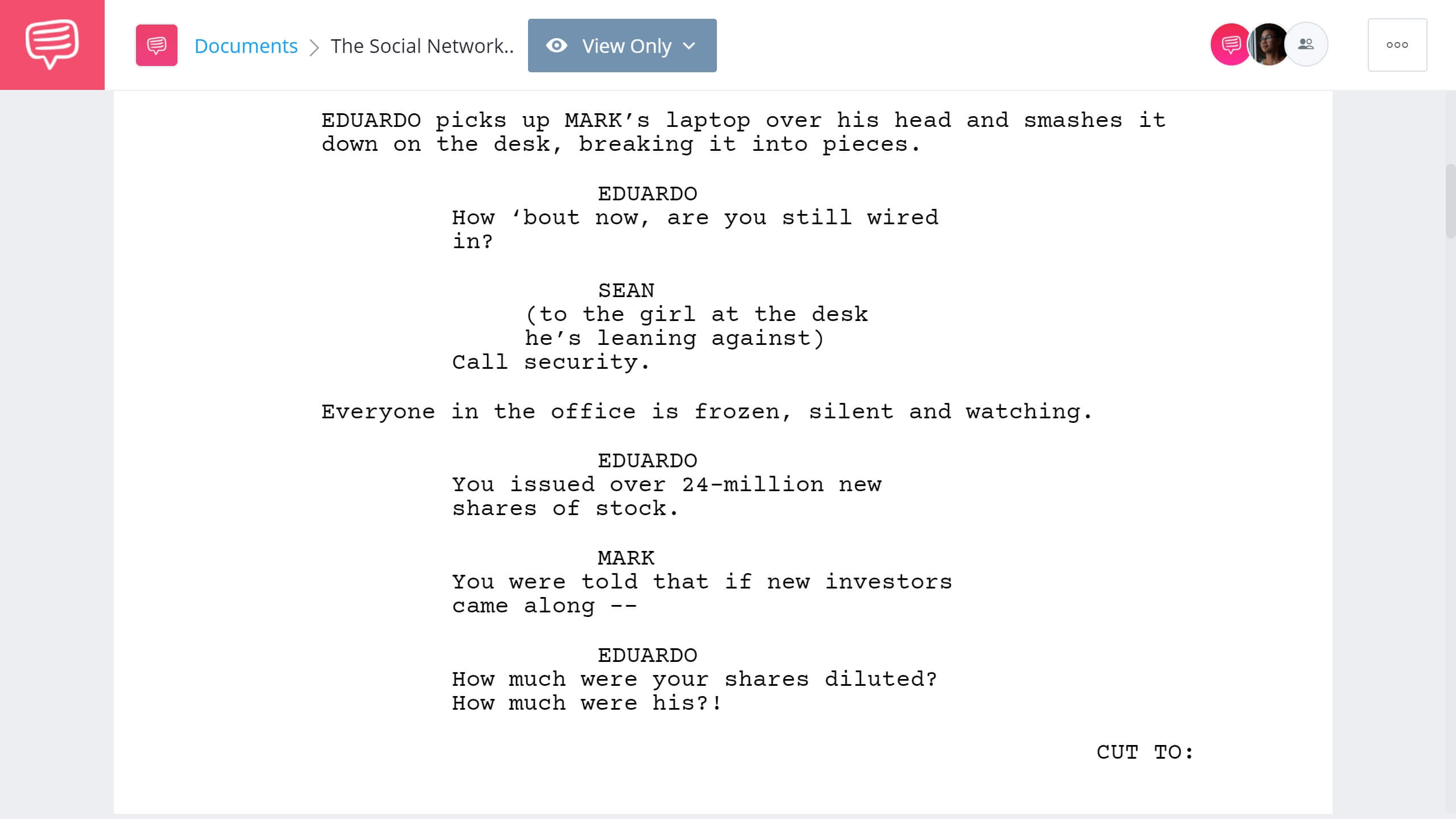How do writers make characters into people we can empathize with and understand? One way is through the use of characterization. But what is characterization? We’re going to answer that question by looking at examples from Kill Bill and The Social Network, and by listening to the perspective of some of the world’s most foremost writers. But before we get into the examples, let’s review what makes direct characterization different from indirect characterization.
What Does Characterization Mean
Let's define characterization
What is characterization? The most simple explanation is the process of creating a character. In fiction, the writer's job is to build their characters from the ground up — who are they, where are they from, what's their defining qualities, etc. But that doesn't mean that writers of non-fiction or biopics based on real people can ignore this process.
Before we jump into some examples and the different types, let's define characterization and why it's important.
CHARACTERIZATION DEFINITION
What is characterization?
Characterization is the process through which an artist communicates character to an audience. In writing, characterization is achieved through dialogue, actions, and descriptions. In visual mediums, characterization is still achieved through dialogue, actions, and descriptions, but it can also be achieved through costuming, hair and makeup, etc. The writer and/or director have made a series of decisions of how to present each character to the reader or audience. Everything they decide to include in this presentation is part of the characterization.
Types of Characterization:
- Direct characterization
- Indirect characterization
- Third Person Referentia
Types of Characterization
Direct vs. indirect characterization
There are two types of characterization: direct and indirect. These types are almost always used in conjunction to support each other. At the same time, it's important to realize that these types of characterization have their unique values and should be given equal attention when writing.
Direct: How a character appears — their physical appearance and profession.
Here’s an example of direct characterization in Goodfellas.Characterization Examples • Direct Characterization in Goodfellas
We learn a lot about Jimmy’s (Robert De Niro) character just from his physical appearance — his slicked back hair, clean-shaven face, fine-tailored suit, etc. We’re able to tell that Jimmy is well-put together, or at the very least, he appears to be.
Indirect: How a character operates — their actions, thoughts, and opinions.
Here’s an example of indirect characterization also from Goodfellas.
Characterization Examples • Indirect Characterization in Goodfellas
In this scene, we learn about Jimmy’s character by what he says and what he does. Dialogue and actions are the two most important facets of indirect characterization.
How to Build Characters
A simple approach to characterization
It’s a lot easier to utilize characterization than you might think. One way to make sure you cover all the bases of characterization is to think about the acronym S.T.E.A.L.
- Speech: What a character says and how they say it; vernacular, accent, etc.
- Thoughts: What a character thinks and believes.
- Effects on Others: How a character interacts with and influences others.
- Actions: Everything a character does.
- Looks: How a character looks and appears; clothing, hair, etc.
By using STEAL characterization, you’ll have the basics of characterization covered. However, if you’re going to create complex characters, you’re going to need to develop them beyond the basics.
This next video does a great job of explaining how Aaron Sorkin develops characters. As you watch, keep in mind all of the aspects of STEAL characterization and how they might apply to Sorkin’s characters.
Aaron Sorkin on the Question ‘What is Characterization?’
So, if STEAL characterization shows us how to construct characters, Sorkin’s strategy, as outlined by Jack’s Movie Reviews, shows us how to develop them. Every character has to fail, find support, re-engage in conflict, then succeed at a cost. There’s something precisely mathematical about the way that Sorkin writes characters. By learning from how he does it, we’re better equipped to create compelling characters too.
What is Characterization in Screenwriting?
What's characterization in screenwriting
What are some considerations writers have with characterization in screenwriting? This process can be achieved through many different methods in screenwriting — but the first, and arguably most important aspect of building a character, is their first description.
In proper screenwriting format, whenever a new character is introduced in a screenplay, their name is written in all caps, along with a brief description of their physical appearance.
The first description is meant to give us an essential aspect of character. We imported the Kill Bill: Vol. 1 script into StudioBinder’s screenwriting software to take a closer look at how Quentin Tarantino introduces characters.
What’s Characterization to Tarantino? • Read the Kill Bill Screenplay
As you can see, The Bride’s introduction in the Kill Bill screenplay is clear. We’re shown who she is, what she’s doing, and where she might be going. But introductions are just one part of building a character — without development, characters will feel hollow.
It’s taboo to write in a character’s internal thoughts/feelings into a screenplay. Therefore, you must use actions and dialogue to communicate how a character feels. Say a character is angry. You can’t just write “my character is angry.”
You have to characterize them through what they say and what they do. Take The Social Network for example. In this next scene, Eduardo confronts Mark over his removal from Facebook.
Click the script image to read the confrontational scene in its entirety and pay attention to Eduardo's actions and dialogue.
Types of Characterization Explained • Read The Entire Social Network Scene
Let’s think about how Sorkin constructs this scene. First and foremost, there’s clear conflict between Eduardo, Mark, and Sean. Second, there’s an added layer of emotional weight due to the heightened stakes of the scene. Third, there’s explosive action — not like Die Hard explosive, but explosive nonetheless.
“EDUARDO picks up MARK’s laptop over his head and smashes it down on the desk, breaking it into pieces.”
This is an important moment for our characters. It literally and metaphorically represents the fracturing of everything they built together. Notice how Sorkin, as the writer, keeps himself out of the scene? By using actions and dialogue, Sorkin characterizes in an indirect way.
Oh, and Eduardo’s line, “Sorry, my Prada’s at the cleaners along with my hoodie and my f-you flip-flops, you pretentious douchebag” blends direct and indirect characterization in a brilliant way.
Characterization is one of the most important facets of storytelling. Perhaps it’s trite to say, but without characters we care about, a story collapses under its own weight. By utilizing S.T.E.A.L. and by heeding Tarantino and Sorkin’s advice, you’ll be ready to build/develop complex characters.
UP NEXT
Write stronger characters
There’s a lot that goes into making a great character — much more than we touched on in this post about characterization. Up next, we analyze how plot and tone are used to develop characters and create situational conflict. We’ll also show you how to use a character development worksheet to organize your character’s actions and beliefs from beginning to end.


